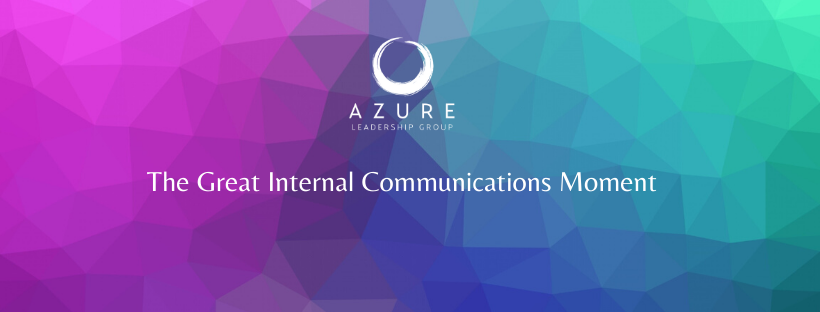Internal Communications is at last having its moment. The Coronavirus pandemic is re-ordering so much of how we work and our economy. It's causing many organizations to re-think old ideas about face time and remote work, many rooted in bias. And it's causing most, if not all, organizations to prioritize internal communications now more than ever.
Without people and employees, most organizations would not exist, and internal comms is moving now to front and center as a key driver of business and strategy.
In every conversation I've had with leaders and communications professionals in the last month, they are all spending almost all of their time on internal communications -- devoting more time and more resources to it, and realizing just how important it is for leaders to communicate with their people effectively, and some even now, finally focusing on it for the first time.
What makes good internal communications?
It's clear messages and effective channels, and it requires leaders being visible and communicating daily, being as transparent as possible and maintaining multiple ways for employees to connect and share their experiences.
Messages, media and messenger -- and it's all about empathy and connection.
Really this is about effective listening and focusing less on pushing out a message or a platitude, and more about making sure people feel acknowledged, heard, and cared for. It's a two-way conversation, not an internal marketing campaign. Internal comms is not just internal PR.
This moment also means the great internal comms re-awakening is happening now, and all organizations need to be ready.
How each organization does this is unique to the specific organization, people, and culture. I like to think about three internal comms truths related to leaders, tools, and people.
Three key internal comms truths
FIRST: Leadership communication has never been more important. I work with countless leaders across industry on communicating effectively in their capacity as a leader, and in every situation a few truths stand out:
They work at it and put effort into it, and prioritize it. It's something we can all get better at and requires practice.
They communicate like normal, reasonable people and like themselves. Pretending to be something they are not or putting on a facade, especially in a time of crisis never works because they've made it more about themselves than about connecting with their audience, who need reassurance and clear information more than ever.
They remind people that we are all on the same team, and they demonstrate and understanding of feelings and emotions of their people, and in so doing, they motivate them.
They are direct. They set clear expectations and share hard facts, they prepared people for what to expect, recognizing they might be hard, but don't bury or paper over facts and information.
I think of San Francisco Mayor London Breed and New York Governor Andrew Cuomo as great examples here. Communicating with their constituents is a master class in how to do internal comms well, simply viewed externally. Both of these leaders communicate facts and understanding of feelings and empathy at the same time, regularly and often. They just multiple channels to get key information out. And they set expectations early and often for what people can expect.
SECOND: Use new tools and new ways of working to empower everyone to get better at communicating. Zoom, slack, Workplace by Facebook and all sorts of other internal comms tools are great at helping us cut through corporate-speak, platitudes and jargon and dispensing with presentation and formality. If you want to put people first, it means cutting through jargon or spin and getting directly to people. How you use these tools effectively depends on mastering tools and behavior. Use all the functionality of these tools well, set up the right channels -- AND be clear about telling people how you want them to use those tools.
THIRD: People matter above all else. Internal communications is really the very essence of communications in its purest form -- the root of the word "communicate" is to commune, to connect, to come together. The best internal communications - and what this moment and reordering of the way we work requires -- means adopting an attitude that the people you're communicating with matter, are colleagues, and so you treat them with respect, openness and integrity.
Specifically, this means being clear about sharing information, setting expectations, sharing what you know and what you don’t, the reasoning behind decisions, and giving people multiple opportunities to share their reactions, feelings, ask questions, to feel heard.
___
Internal comms is at last moving from a step-child or ancillary part of a communications or human resources function to a necessary and strategic part of how organizations are successful in the future. The best companies prioritize it and marry it with external communications, and the best leaders prioritize it too.







